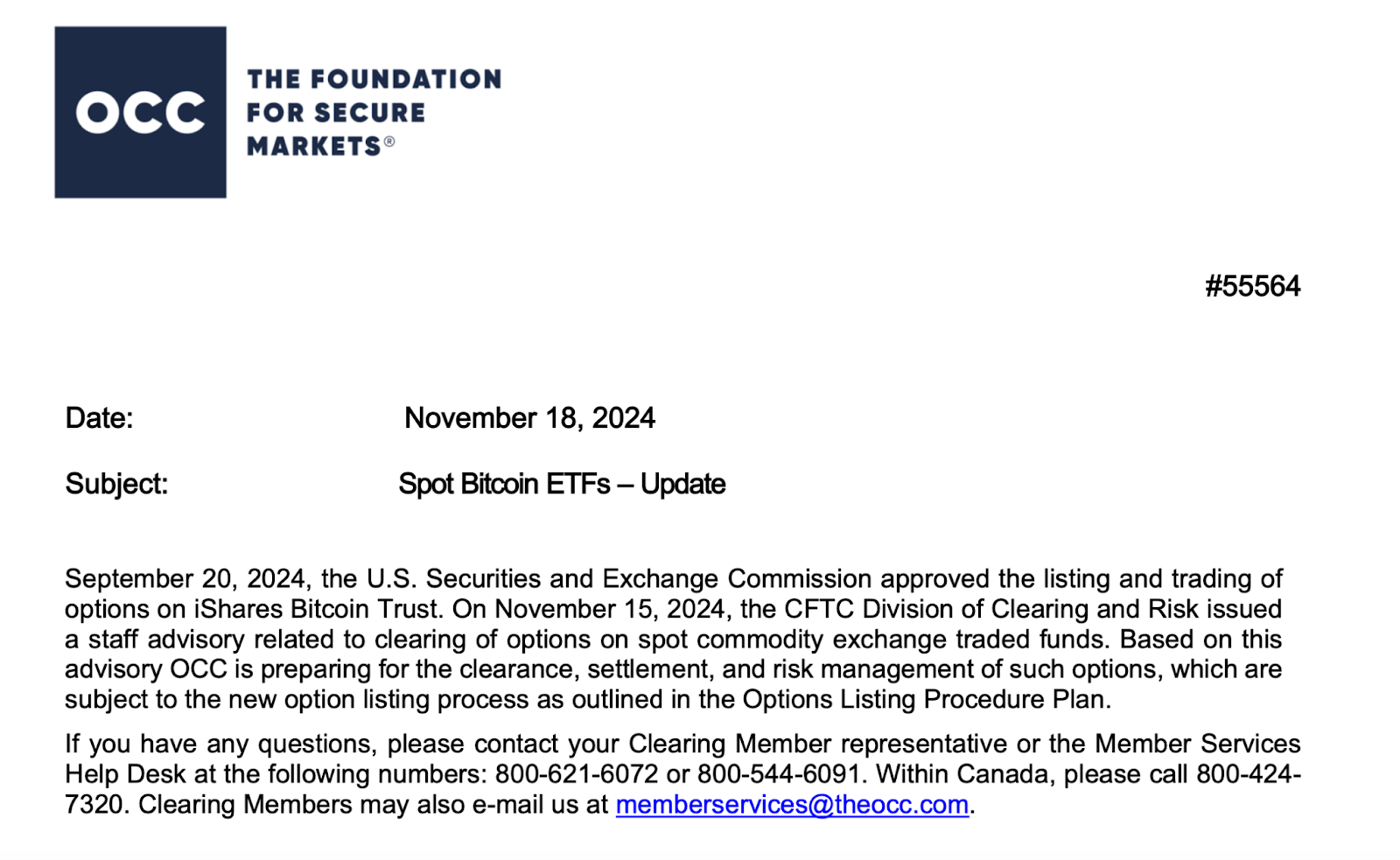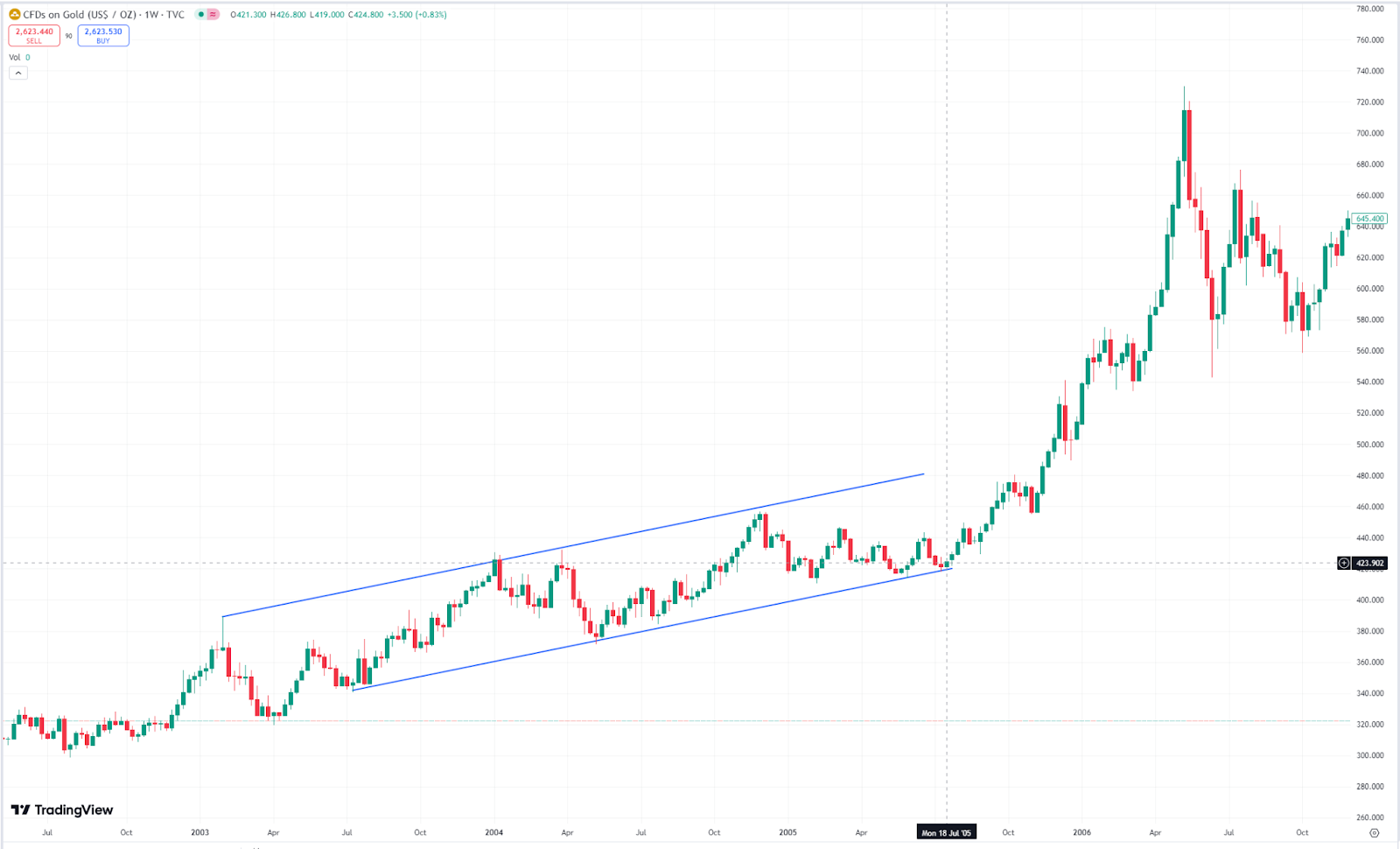As the iShares Bit Trust (IBIT) ETF options of BlackRock (BlackRock) are set to officially launch on Nasdaq on Tuesday, the Bit market is witnessing a milestone moment.
After months of regulatory advancement and repeated consultations, the Options Clearing Corporation (OCC) recently updated the relevant documents, approving the inclusion of this $43 billion financial product in the trading scope, marking an acceleration of the financialization process of Bit.

Source: OCC
Not long ago, BlackRock had withdrawn the ETF application, but now this options trading has been successfully approved in September, and the Securities and Exchange Commission (SEC) has also approved the relevant rule changes during the same period. In addition to BlackRock, other heavyweight products in the Bit field have also begun to gain the favor of the options market - including the Grayscale Bit Trust (GBTC) and the Bitwise Bit ETF (BITB), which have already obtained the support of options trading. Market giants such as Cboe and Fidelity have also joined the race, providing more participation opportunities for the Bit market.
But the question is:What do the launches of these ETF options mean? Will they fundamentally change the price trend of Bit and trigger a revolution in the global financial system? At this critical juncture, let's review the history and explore the far-reaching impact of this financial instrument innovation, taking into account the unique characteristics of the Bit market.
The Significant Implications of Bit ETF Options
1. The Basic Functions and Roles of ETF Options
First, we need to understand what ETF options are. ETF (Exchange-Traded Fund) options are a type of derivative trading tool that gives investors the right to buy or sell a specific ETF fund unit at a predetermined price at a specific time in the future. Similar to traditional stock options, ETF options allow investors to use leverage to speculate or hedge risks in the market. In simple terms, ETF options are a derivative based on ETFs, which provide investors with more investment strategy choices, including hedging, speculation, and arbitrage.
For the Bit market, the launch of ETF options not only increases the diversity of investment tools, but also injects more liquidity into the market. This increased liquidity can not only stimulate market activity, but also to some extent alleviate the volatility of the Bit market through hedging transactions. Specifically, the introduction of ETF options will bring more market participation opportunities for institutional investors, who can use option tools to predict and manage the fluctuations of Bit prices, thereby balancing risks and obtaining excess returns.
For example:
Suppose you purchase an option on a Bit ETF, which gives you the right to buy that Bit ETF at a price of $50 per unit on a future date. If the market price of the Bit ETF rises to $60 by that date, you can exercise your option to buy the ETF at $50 and then immediately sell it at the market price of $60, thereby making a profit of $10.
However, if the ETF price only rises to $55 or even declines by that date, you do not have to exercise the option, as you can choose not to exercise it (this situation is like forfeiting the deposit you have already paid). Therefore, options bring you flexibility and risk management opportunities.
Differences between ETFs and ETF options:
- ETFs: They are an investment tool, essentially a fund that can be traded on a securities exchange, usually tracking the performance of a certain asset class (such as Bit, gold, S&P 500 index, etc.). Buying an ETF means you are buying a basket of assets it contains, and you can sell it at any time, allowing investors to gain exposure to the market performance of the asset.
- ETF options: They are a derivative, which does not directly represent the ETF itself, but rather gives you the right to buy or sell the ETF in the future. Options are a contract that allows, but does not oblige, you to buy or sell a certain ETF at a predetermined price at a specific future time. This means that the value of the option depends not only on the price changes of the ETF, but also on factors such as the expiration time and the exercise price of the option.
Key differences:
- Different in holding nature: Buying an ETF means you directly hold the assets of the fund, while ETF options are just a "purchase" right, not the assets themselves.
- Different in risk and return mechanism: The risk and return of ETFs are directly linked to market prices (prices go up, you make a profit; prices go down, you lose), while ETF options involve the question of whether to exercise or not, and have time limits. The option premium you pay is the maximum loss you can bear, while the potential gain can be very large (such as when the ETF price rises).
- Different in usage purpose: ETFs are usually long-term investment tools used to track the overall performance of assets; while ETF options are more often used for short-term trading, risk hedging or enhanced strategies.
How the Options Market Can Affect Bit Prices
1. Improved Liquidity
The addition of the options market will inevitably increase the liquidity of the Bit market. Liquidity is often considered one of the important health indicators of the financial market. Options provide investors with more trading opportunities, especially able to attract a large amount of institutional capital to participate in the market. Institutional investors are usually more inclined to use option tools to hedge market risks, which diversifies the market participants structure of Bit, thereby driving capital inflows. This market liquidity can not only increase market activity, but also provide more buying support for the rise of Bit prices, thereby avoiding the violent fluctuations caused by market panic or sell-offs.
2. Hedging and Stabilizing Effects
The introduction of option tools, especially the launch of ETF options, means that investors can better hedge the volatility of the Bit market. As a new emerging asset, Bit has always been known for its high volatility, and the violent price fluctuations have deterred many investors. The existence of the options market provides investors with tools to mitigate this risk. Investors can hedge the downside risk of the market by buying put options, or share the upside gains of the market by buying call options. The increase of these hedging behaviors may reduce the volatility of the Bit market and make the market more stable. Especially in the case of capital inflows, this hedging behavior may amplify the upward trend, driving a steady long-term growth in Bit prices.
3. Speculation and Leverage Effects
In addition to hedging risks, ETF options also provide investors with speculative opportunities. Through options, investors can use relatively little capital to gain larger market returns through leverage. This leverage effect can amplify both returns and risks, but its impact on the market cannot be ignored. Since option trading allows investors to control larger positions, it may lead to stronger market reactions, especially when prices break through key technical levels. Given the high volatility of Bit prices, the addition of the options market may increase short-term market volatility, but it can also stimulate more speculative capital inflows, thereby driving price increases.
Lessons from the Gold ETF Options: Moderate Increase or Significant Volatility?

In 2004, the gold market welcomed the launch of ETF options. At that time, gold prices were fluctuating between $400-$420. After the options launch, the price of gold did not immediately experience an explosive increase, but instead maintained a moderate upward trend within three months.
By mid-2005, the gold price easily broke through $450 and then soared to a new high of $700.
Although there was no violent fluctuation at the beginning, in the long run, the introduction of options injected more liquidity into the market, attracting a large number of investors and driving the sustained rise in gold prices.
Therefore, the launch of gold ETF options did not have an immediate impact, but rather brought about a gradual market response, gradually driving up the price of gold. This, when viewed in the context of today's Bitcoin market, seems to have some similar shadows.
Bitcoin ETF Options: The "Golden Age" or "Short-term Speculation" of the Cryptocurrency Market?
You may ask: "Will this be like gold, becoming a driving force in the market?" The answer may be affirmative, but the specific effects need to be viewed in stages.

Short-term (within 1-3 months): Volatility remains the protagonist
First, we need to recognize that the volatility of the Bitcoin market is much greater than that of gold. Gold is seen as a safe-haven asset during global economic turmoil, while Bitcoin, as a decentralized digital currency, is still in a relatively immature market. The price of Bitcoin is often affected by multiple factors such as macroeconomic conditions, policy changes, and investment sentiment, which leads to more violent price fluctuations.
Even so, the launch of ETF options will inject more liquidity into the Bitcoin market and attract more institutional investors to participate. The launch of Bitcoin ETF options means that institutional investors can hedge risks and conduct strategic trading, or even speculation, more flexibly. Although these operations will not immediately bring about explosive growth, the activity and liquidity of the market will inevitably be enhanced. The price of Bitcoin may experience a moderate rise, but the volatility in the short term will still be very intense, and the price may fluctuate between $85,000 and $10,000.
Medium-term (within 6 months to 1 year): Outbreak of market confidence
From a medium-term perspective, the launch of Bitcoin ETF options may play a catalytic role. The launch of gold ETF options has expanded the investor base in the gold market and gradually driven up the price. For Bitcoin, the participation of institutional capital is undoubtedly a strong support for the market. The participation of institutional investors not only stabilizes market sentiment, but also brings more speculative and hedging demand to the Bitcoin market.
If we look further ahead, we may find that there is room for Bitcoin to rise, especially when market confidence erupts. The $100,000 mark is a very critical psychological level, and as more and more institutional investors enter the market, the possibility of this breakthrough is also gradually increasing. If the global economy experiences inflation, the US dollar weakens, or economic uncertainty increases, the safe-haven attribute of Bitcoin will be recognized by more people, and the driving force for its price increase will be stronger.
Conclusion: Bitcoin Enters a New Era, and a Major Market Shift May Be Imminent
The launch of BlackRock's Bitcoin ETF options not only marks the further maturity of the Bitcoin market, but also provides institutional investors with more flexible trading tools and risk management means. With more capital flowing in, the potential for Bitcoin to break through $100,000 is becoming increasingly apparent, and the long-term prospects of the market are undoubtedly promising.
It is worth noting that Bitcoin ETF options will officially start trading tomorrow, and at the same time, another major event that the market is focusing on - the Nvidia earnings report - will also be unveiled. For investors, this may be a memorable moment, and perhaps the huge pump or crash in the market will be generated at the intersection of these two major events. Will Bitcoin lead a new round of frenzy, or will the market sentiment suddenly reverse? The answers will soon be revealed.




